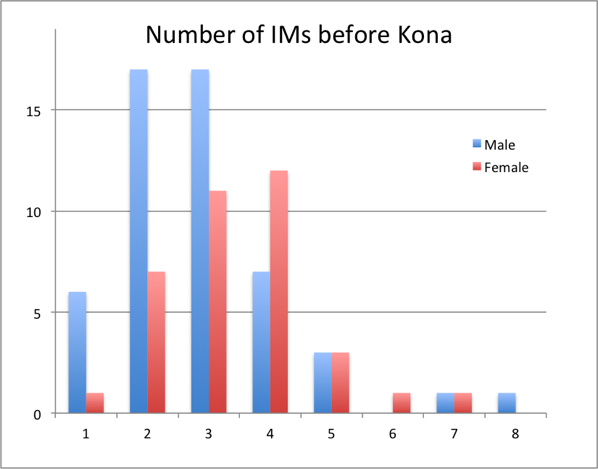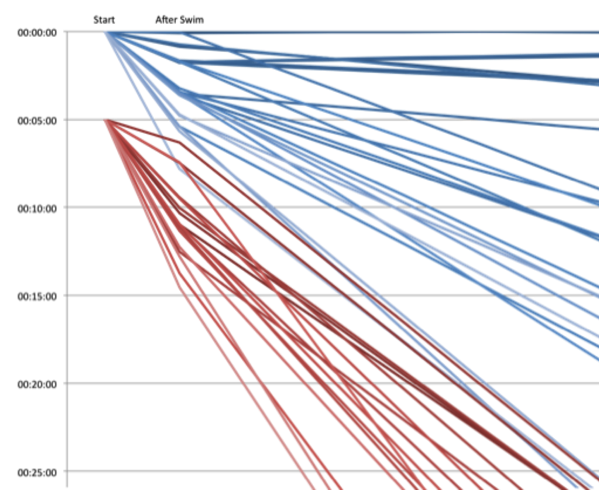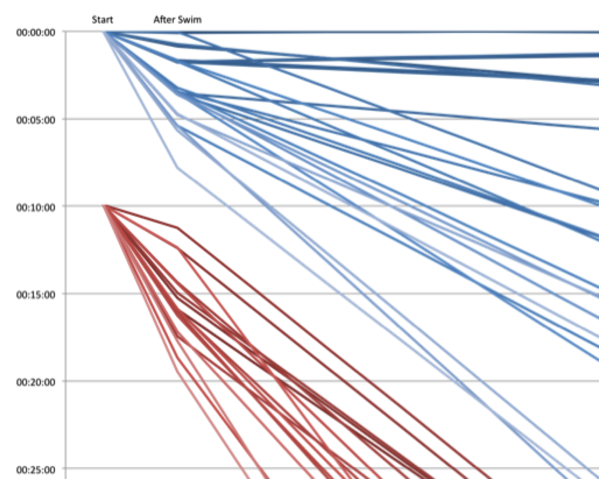There has been a lot of discussion on social media about Kona slots and the fact that there are only 35 slots for female Pros and 50 for the men. A lot of people have been arguing for equal WPRO slots in Kona, spearheaded by the #50WomenToKona initiative which has recently solidified into TriEqual (which I am a part of).
While there are a lot of public statements that deserve a longer reply, I would like to use this post to explain my position and the reasoning behind it in a better way than what is possible in the bite-sized format of Twitter.
General Slot Assignment
When space in a race is limited, there has to be some way of choosing the athletes that are allowed to take part in the race. This is especially true for “Championship” type of races such as Kona or ITU championships.
The way I understand it, the ITU has decided to allocate the same number of slots for their championship races to each age group (further breaking it down to x slots per member federation). Ironman has always had a proportional slot assignment: the larger an agegroup in a qualifying race, the more Kona slots will be allocated to it. This also allows the slot assignment to dynamically adapt to changes in the size of agegroups.
In principle, I think that proportional assignment is a rational way to allocate slots. A fixed number of slots leads to agegroups that are “harder” or “easier” to qualify for – the chances to qualify are mainly a function of how large an agegroup is. With proportional slots, the “bigger market” also gets a larger part of the slots and generally the strength and depth of the field in the championship race will be higher. As long as there is a reasonable number of participants per agegroup in the championship race, there is a low risk of someone failing to qualify that has a shot of placing very well. (For Kona 2014, only the Physically Challenged, WPRO, F-18-24, women older than 60 and men older than 70 had fewer than 40 participants.) Because the Kona agegroup qualifying system guarantees at least one slot per race to each agegroup, it also has a “built in protection” for smaller agegroups.
Why is there so much criticism about the agegroup qualifying system? To me, Ironman is a victim of their own successful expansion: Because Kona is the main selling proposition over Challenge, each new Ironman race requires additional Kona qualifier slots. (The latest new races in Vichy, the Netherlands and Muskoka each have 50 slots.) Obviously, there is limited capability for growing the race in Kona, so adding more races is only possible by taking away slots from existing races. If I remember correctly, around 2005 Frankfurt used to have 150 Kona slots, it is now reduced to 75 slots. The lower number of slots (the recent IM Taiwan only had 25 slots) means that the protection of the smaller agegroups is stronger than with a larger number of slots, and adding new races requires a constant re-juggling of slots. (With the KPR for Pros, adding a new race doesn’t require any changes to the general qualifying system or points-designations.) Also, with fewer slots luck plays a stronger role in qualifying – you have no control over who actually shows up at the race you choose for qualifying. As Ironman will continue to expand, these systems will only get larger over the next years. Therefore, the agegroup qualifying system needs to be updated. Still, proportional slot assignment leads overall to a relatively fair slots distribution and also has a built-in mechanism for adjusting to shifts in the distribution between genders and agegroups.
Why am I #50WomenToKona?
Having said the above, it might come as a bit of a surprise that I support the #50WomenToKona movement that argues for equal female Pro slots in Kona. Here is the tweet that I sent out on March 21st for the first big #50WomenToKona push on social media:

So why do I support a proportional slot assignment and equal female Pro slots? I think that proportional female Pro slots are an exception to the the general rule. Ironman and their CEO Andrew Messick think that having 35 slots for the Pro women is actually a good deal for them as a purely proportional approach would give them an even lower number of slots. Here is what Andrew said in a recent interview on IMTalk:
Women professional athletes have an easier path to Kona than their male counterparts.
I strongly disagree with Andrew’s statement; instead the KPR system with a lower number of female slots actually leads to severe disadvantages for all Pro women.
Here are a few observations supporting this position:
- Female Pros need more points for a Kona slot.
The 2014 July numbers were roughly 4.800 points for the females and 3.500 points for the male. Simplifying things a bit, a male Pro can qualify by racing one Ironman race and a few 70.3s, while a women needs at least two or three full IMs. Also, women are pushed towards the big points races as winning a normal P-2000 Ironman race isn’t even half of what is needed for a Kona slot.
Although the rules for male and female Pros are the same, the difference in slots essentially creates two different qualifying systems.
- Because of the different cutoffs resulting from the different number of slots, female Pros have to race more often than male Pros for a Kona slot, usually resulting in higher costs for them that are not necessarily offset by making more prize money.
For Kona 2014, the average number of IMs of the male Pros is 2.8, while the female Pros had raced 3.4 IMs.
- As more racing is needed, it is harder to prioritize Kona in order to have a good performance at the World Championships. If women have to race more often, there is less time to properly rest after their last qualifying IM and also have a focused Kona build. Essentially the men’s Kona Pro field is better rested than the women’s field, creating two different Kona races.
For example Kona 2014 2nd place finisher Ben Hoffmann wouldn’t have qualified as a women, he would have been forced to do another IM instead of being able to prepare for his great Kona performance.
- Ironman always stresses that they pay equal prize money to men and women. While this is correct, a large part of athlete’s earnings are sponsors payments – and fewer Kona qualifiers means that fewer women have the chance to use this as their “calling card”. Also sponsors typically pay bonuses for Kona qualifying and representing their brands in Kona. Therefore unequal Kona slots create unequal earning opportunities for female Pros.
These differences are a direct result of the unequal number of slots. They affect all professional female athletes – those that qualify for Kona and those who don’t. This is different from qualifying under a proportional system in agegroup ranks: Regardless of the number of slots a female agegrouper can qualify in one Ironman and then focus on their Kona build.
Summary
All of this discussion supports my main point about Kona qualifying: Proportional slot assignment is basically a fair system, but the unequal slots in the KPR create clear inequalities between male and female professionals. Ironman should create equal professional slots as soon as possible in order to avoid these inequalities. They should also be careful not to introduce the same problems when updating their agegroup qualifying system.




